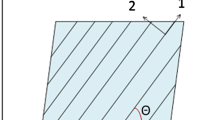Abstract
Thermoplastic composites are widely considered in structural parts. In this paper attention is paid to squeeze flow of continuous fiber laminates. In the case of unidirectional prepregs, the ply constitutive equation is modeled as a transversally isotropic fluid, that must satisfy both the fiber inextensibility as well as the fluid incompressibility. When laminate is squeezed the flow kinematics exhibits a complex dependency along the laminate thickness requiring a detailed velocity description through the thickness. In a former work the solution making use of an in-plane-out-of-plane separated representation within the PGD – Poper Generalized Decomposition – framework was successfully accomplished when both kinematic constraints (inextensibility and incompressibility) were introduced using a penalty formulation for circumventing the LBB constraints. However, such a formulation makes difficult the calculation on fiber tractions and compression forces, the last required in rheological characterizations. In this paper the former penalty formulation is substituted by a mixed formulation that makes use of two Lagrange multipliers, while addressing the LBB stability conditions within the separated representation framework, questions never until now addressed.

















Similar content being viewed by others
References
Aghighi S, Ammar A, Metivier C, Normandin M, Chinesta F (2013) Non incremental transient solution of the Rayleigh-Bénard convection model using the PGD. J Non-Newtonian Fluid Mech 200:65–78
Aghighi MS, Ammar A,Metivier C, Chinesta F (2015) Parametric solution of the Rayleigh-Bénard convection model by using the PGD: application to nanofluids. Int J Numer Methods Heat Fluid Flow 25(6):1252–1281
Ammar A, Mokdad B, Chinesta F, Keunings R (2006) A new family of solvers for some classes of multidimensional partial differential equations encountered in kinetic theory modeling of complex fluids. J Non-Newtonian Fluid Mech 139:153–176
Barnes JA, Cogswell FN (1989) Transverse flow processes in continuous fibre-reinforced thermoplastic composites. Composites 20/1:38–42
Bersee HEN, Beukers A (2003) Consolidation of thermoplastic composites. J Thermoplast Compos Mater 16/5:433–455
Bognet B, Leygue A, Chinesta F, Poitou A, Bordeu F (2012) Advanced simulation of models defined in plate geometries: 3D solutions with 2D computational complexity. Comput Methods Appl Mech Eng 201:1–12
Chinesta F, Ammar A, Leygue A, Keunings R (2011) An overview of the proper generalized decomposition with applications in computational rheology. J Non-Newtonian Fluid Mech 166:578–592
Chinesta F, Leygue A, Bognet B, Ghnatios C, Poulhaon F, Bordeu F, Barasinski A, Poitou A, Chatel S, Maison-Le-Poec S (2014) First steps towards an advanced simulation of composites manufacturing by automated tape placement. Int J Mater Form 7(1):81–92. http://www.springerlink.com/index/10.1007/s12289-012-1112-9
Ericksen JL (1959) Anisotropic fluids. Archive for rational mechanics and analysis, 231–237
Ghnatios C, Chinesta F, Binetruy C (2015) The squeeze flow of composite laminates. Int J Mater Form 8:73–83
Ghnatios C, Abisset-Chavanne E, Binetruy C, Chinesta F, Advani S 3D modeling of squeeze flow of multiaxial laminates. J Non-Newtonian Fluid Mech. In Press. doi:10.1016/j.jnnfm.2016.06.004
Goshawk JA, Navez VP, Jones RS (1997) Squeezing flow of continuous fibre-reinforced composites. J Non-Newtonian Fluid Mech 73/3:327–342
Groves DJ, Bellamy AM, Stocks DM (1992) Anisotropic rheology of continuous fibre thermoplastic composites. Composites 23/2:75–80
Gutowski TG, Cai Z, Bauer S, Boucher D, Kingery J, Wineman S (1987) Consolidation experiments for laminate composites. J Compos Mater 21/7:650–669
Shuler SF, Advani SG (1996) Transverse squeeze flow of concentrated aligned fibers in viscous fluids. J Non-Newtonian Fluid Mech 65:47–74
Shuler SF, Advani S (1997) Flow instabilities during the squeeze flow of multiaxial laminates. J Compos Mater 31/21:2156–2160
Spencer AJM (2000) Theory of fabric-reinforced viscous fluids. Compos Part A 31:1311–1321
Author information
Authors and Affiliations
Corresponding author
Ethics declarations
The authors declare that they have no conflict of interest.
Appendix: A: Separated representation of the Stokes weak form
Appendix: A: Separated representation of the Stokes weak form
The efficient computer implementation of the separated representation constructor discussed in “Separated representation constructor” section needs a separated form of the flow problem expressed in a weak form (7). For that purpose we first consider the second term D ∗:D, that takes into account expression (5) as follows
The simplest choice of the test function v ∗(x,z) is
from which the velocity gradient is:
The choice of \(\mathbb {P}\) and \(\mathbb {T}\) in Eq. 56 is discussed in “Separated representation constructor” section.
Developing the first term in Eq. 54 (the other terms follow the same rationale) taking into account Eq. 3 results
It is easy to note that if matrices \(\mathbb {M}(\mathbf {x})\) and \(\mathbb {N}(\mathbf {x})\) depend on the in-plane coordinates x, and matrices \(\mathbb {U}(z)\) and \(\mathbb {V}(z)\) depend on the out-of-plane coordinate z, we have
Using this equality, Eq. 57 can be written as
and the other terms involved in Eq. 54 as
and
Thus, we finally obtain
where ∀j, j=1,⋯,N
and
On the other hand, the first term in Eq. 7 can be expressed as:
with
Thus, a generic term in Eq. 68 can be written as
Now, by defining \(\mathcal {V}(\mathbb {J})\) the vector form of the diagonal matrix \(\mathbb {J}\), Eq. 70 results
that allows finally casting the first term in the weak form (7) as
with
and
Rights and permissions
About this article
Cite this article
Ibáñez, R., Abisset-Chavanne, E., Chinesta, F. et al. Simulating squeeze flows in multiaxial laminates: towards fully 3D mixed formulations. Int J Mater Form 10, 653–669 (2017). https://doi.org/10.1007/s12289-016-1309-4
Received:
Accepted:
Published:
Issue Date:
DOI: https://doi.org/10.1007/s12289-016-1309-4




